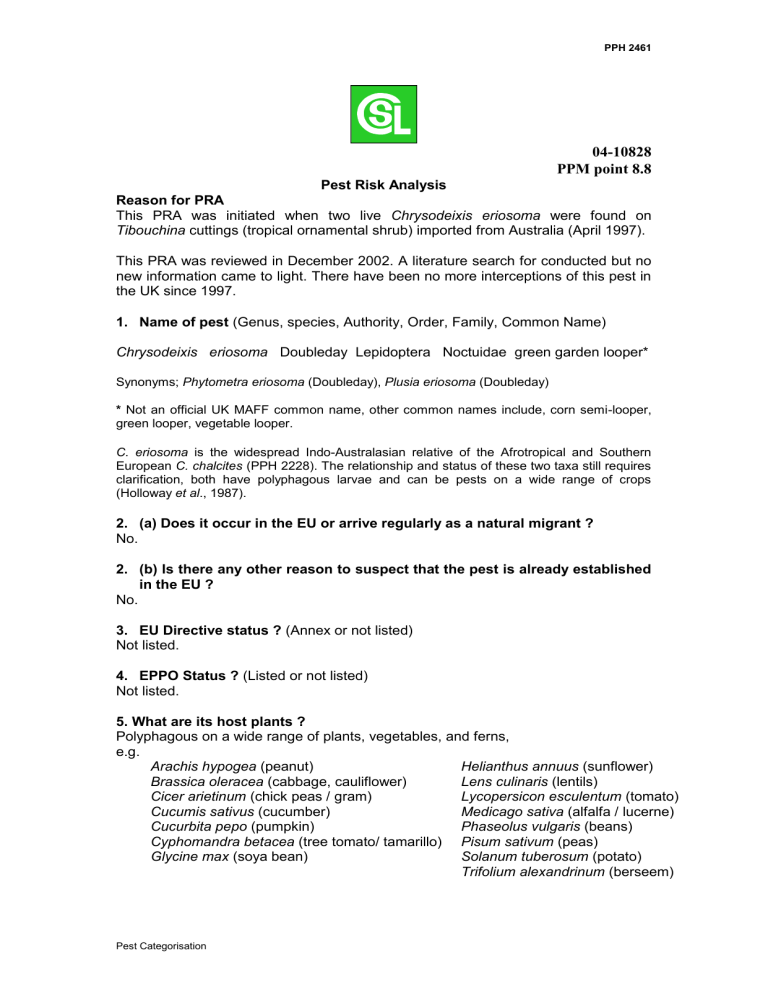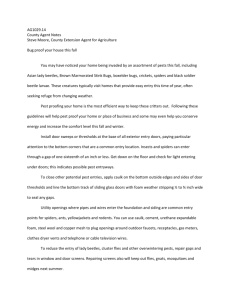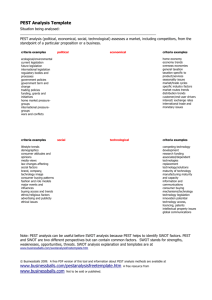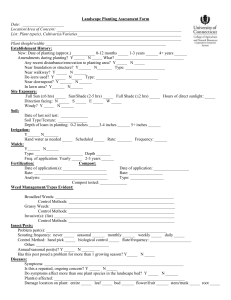04/10828 - European and Mediterranean Plant Protection

PPH 2461
04-10828
PPM point 8.8
Pest Risk Analysis
Reason for PRA
This PRA was initiated when two live Chrysodeixis eriosoma were found on
Tibouchina cuttings (tropical ornamental shrub) imported from Australia (April 1997).
This PRA was reviewed in December 2002. A literature search for conducted but no new information came to light. There have been no more interceptions of this pest in the UK since 1997.
1. Name of pest (Genus, species, Authority, Order, Family, Common Name)
Chrysodeixis eriosoma Doubleday Lepidoptera Noctuidae green garden looper*
Synonyms; Phytometra eriosoma (Doubleday), Plusia eriosoma (Doubleday)
* Not an official UK MAFF common name, other common names include, corn semi-looper, green looper, vegetable looper.
C. eriosoma is the widespread Indo-Australasian relative of the Afrotropical and Southern
European C. chalcites (PPH 2228). The relationship and status of these two taxa still requires clarification, both have polyphagous larvae and can be pests on a wide range of crops
(Holloway et al ., 1987).
2. (a) Does it occur in the EU or arrive regularly as a natural migrant ?
No.
2. (b) Is there any other reason to suspect that the pest is already established
No. in the EU ?
3. EU Directive status ? (Annex or not listed)
Not listed.
4. EPPO Status ? (Listed or not listed)
Not listed.
5. What are its host plants ?
Polyphagous on a wide range of plants, vegetables, and ferns, e.g.
Arachis hypogea (peanut)
Brassica oleracea (cabbage, cauliflower)
Cicer arietinum (chick peas / gram)
Cucumis sativus (cucumber)
Helianthus annuus
Lens culinaris
Medicago sativa
(sunflower)
(lentils)
Lycopersicon esculentum (tomato)
(alfalfa / lucerne)
Cucurbita pepo (pumpkin)
Cyphomandra betacea (tree tomato/ tamarillo)
Glycine max (soya bean)
Phaseolus vulgaris (beans)
Pisum sativum (peas)
Solanum tuberosum (potato)
Trifolium alexandrinum (berseem)
Pest Categorisation
PPH 2461 also feeds on ornamental plants e.g. Freesia refracta, Tibouchina.
(Jones & Elliot, 1986, Men et al ., 1995; Tripathi & Akhtar, 1986; Tripathi & Tripathi,
1988)
(a) Highlight the crop plants grown economically, including those of environmental / amenity value in the EU.
Many of the above.
(b) Are any of the host plants of forestry importance ?
No.
6. What is its present geographical distribution ?
Widespread in the Indo-Australasian region (Holloway et al ., 1987). Occurs in the temperate and subtropical regions of Australia (Jones & Elliot 1986) including
Tasmania (Hardy et al ., 1982), India, Vietnam (Zeleny et al ., 1982), Malaysia (Khoo et al., 1991), all over the North Island of New Zealand, and the northern parts of the
South Island (Ferro, 1978; Allan, 1987).
7. Does it appear capable of becoming introduced into the EU ?
( Introduction consists of a pest first entering a geographic area and then establishing in the area i.e. sustaining a population in the area (FAO, 1996)).
Could it enter the UK or EU ?
This PRA was initiated when two live specimens were found on Tibouchina cuttings
(tropical ornamental shrub) imported from Australia (Date of arrival 23/4/97,
DOMERO 20091/133).
Could it sustain a population in the UK or EU ?
(a) Outdoors
UK - perhaps in warm and humid locations. It is found in Tasmania and northern parts of New Zealand’s South Island, which have similar maritime climates to the UK.
Outdoors it could threaten beans, cabbage, cauliflower, peas and potatoes.
A comparison of climatic data was made between Southampton (UK) and Hobart
(Tasmania). Fig 1. shows the mean maximum and minimum temperatures between these locations (1931-1960 data from CLIMEX). Accumulated summer temperatures
(May to September), above 5 C, for each location was similar; 1574 degree days for
Southampton and 1650 degree days for Hobart.
EU - Yes, continental Europe could also be threatened by C. eriosoma.
Life cycle
Eggs are laid on the underside of leaves and hatch in 7-10 days in New Zealand
(Ferro, 1978) or 2-4 days in Malaysia. Females lay about 170 eggs each (Khoo et al., 1991). There are five larval instars. Larvae take 4-6 weeks to mature in New
Zealand (2-3 weeks in Malaysia). Young larvae feed on the underside of leaves, leaving the upper leaf cuticle as a transparent membrane. Later instars feed on whole pieces of the leaf. Larvae favour mild, moist and shaded conditions. On legumes larvae may excavate maturing pods. When fully fed, larvae spin silken cocoons attached to the underside of leaves, and brown pupae form within. At 10 -
27 C (45-85% RH), adults emerge from pupae within 13 - 16 days. Development
Pest Categorisation
PPH 2461 varies according to the host food plant. Adult lifespan varies from 7-14 days (Tripathi
& Tripathi, 1988). In Malaysia, it may take only 5 - 6 weeks to complete a generation
(egg to adult to egg) at temperatures between 22 C and 32 C (Tripathi & Shari,
1992), while in New Zealand it takes 7 - 9 weeks. Temperatures of 18- 25 C were optimum for the build up of Chrysodeixis eriosoma populations, relative humidities of
> 90% and rainfall were also important (Tripathi & Akhtar, 1988).
Figure 1: Mean monthly maxima and minima for Southampton (UK) and Hobart (Australia)
25
20
15
10
5
0
S'oton min S'oton max Hobart min Hobart max
(b) on protected crops
UK and EU - This pest could probably survive in protected cultivation, where cucumbers and tomatoes would be at risk.
8. What is its potential likely to be as (i) a pest or (ii) virus vector in the EC ?
(i) This has the potential to become a pest in the UK and EC. Within its present geographical distribution, C. eriosoma can be a significant pest. In New Zealand, C. eriosoma is the most common insect pest of soyabeans. Larvae can cause up to
15% defoliation although this does not reduce seed yields significantly (Cameron et al ., 1986). Soyabeans are now being grown commercially for the first time in the UK
(Anon., 1997). In Australia C. eriosoma is a sporadic pest of limited importance although it can cause serious defoliation in large numbers.
In Tasmania it has damaged ornamental Freesia refracta (Hardy et al., 1982). In India C. eriosoma is a major pest of peas and soyabean (Prasad et al ., 1983; Saha & Saharia, 1983).
(ii) Not a virus vector.
9. What are the prospects for continued exclusion ?
Fair. Currently C. eriosoma is restricted to the Indo- Australasian region. Since adult females lay eggs on the underside of host leaves, it is possible that eggs, developing larvae and pupae, (which hang from leaves) can be carried and spread with international trade. However this pest has not been intercepted previously.
Pest Categorisation
PPH 2461
10. What are the prospects of eradication ?
Good - chemical treatments and bio-pesticides are available.
11. How would eradication be achieved (in summary) ?
Some chemical treatments are effective, e.g. a mixture of 50% pirimiphos-methyl with 50% permethrin gave excellent control of C. eriosoma larvae in tamarillo,
( Cyphomandra betacea ) (Holland et al., 1982). Acephate also gave good control.
Neem oil, chlorfluazuron and triflumuron have been used on cabbage in Sri Lanka
(Bandara & Kudagamage,1991).
Bactospeine, Dipel and Thuricide ( Bacillus thuringiensis subsp. kurstaki ) applied to greenhouse grown tomatoes in New Zealand prevented fruit damage by C. eriosoma larvae (Martin & Workman, 1986).
In Hawaii, experiments with trap crops such as Indian mustard Brassica juncea , and
'Tastie' head cabbage, Brassica oleracea variety capitata showed potential for use as part of an integrated control program (Luther et al ., 1996)
A 10:1 ratio of the pheromones (Z)-7-dodecenyl acetate and (Z)-9-dodecenyl acetate attracted males of C. eriosoma in Japan (Sugie et al ., 1990).
12. Conclusion
Eggs, larvae and pupae of this pest can all be carried on the leaves of host plants. If this pest continues to be carried via trade in ornamentals or vegetables from its existing locations, there is a good chance that it will eventually establish somewhere in the UK or EU. It is highly fecund, mobile, polyphagous and in warm and humid conditions, has a short generation time. Areas at most risk in both the UK and EU, would be protected cultivation, growing vegetables or ornamentals.
Chrysodeixis eriosoma is present in Tasmania and in northern parts of New
Zealands South Island, and may well be able to survive outdoors in the UK and large parts of Europe. Outdoor crops such as potatoes, beans and crucifers would be threatened but to a lesser extent than protected crops since larval development would be slower.
Note: This species appears to be more of a threat than the related Chrysodeixis chalcites which is an occasional migrant to the UK and is intercepted more frequently. C. chalcites is distributed in warmer parts of the world and would probably not survive outdoors in the UK although it could become a pest in protected cultivation.
Pest Categorisation
PPH 2461
13. References
Anon. (1997) Positive outlook for soya production in the UK, Agric. Sup. Ind.
, 27 , (20), 4.
Allan, D.J. (1987) Flight records of four common pest noctuids (Lepidoptera: Noctuidae) in
West Auckland 1978 - 1979. New Zealand Entomologist , 10 , 122-127
Bandara, K. & Kudagamage, C. (1991) Potential of chitin inhibitors and botanical insecticides for the control of cabbage caterpillars. Tropical Agriculturist , 145 , 125-127.
Cameron, P.J., Allan, D.J. & Walker, G.P. (1986) Insect pests and crop damage in soybeans.
New Zealand Journal of Agricultural Research , 29 , (1), 93-100.
FAO (1996) International Standards for Phytosanitary Measures, Part 1- Import Regulations,
Guidelines for Pest Risk Analysis , FAO, Rome, 21p.
Ferro, D. (Ed.) (1978) New Zealand Insect Pests , Lincoln University, 312pp
(CSL Info Centre 632.7(931) Fer)
Hardy, R.J. et al ., (1982) Insect Pest Survey, Tasmanian Dept. of Agriculture. No. 14, 32 pp.
Holland, P.T., McFarlane, D.W., McGhie, T.K. & Hartley, M.J. (1982) Spray programmes for pest and disease control in tamarillos. Proceedings of the Thirty-Fifth New Zealand
Weed and Pest Control Conference.
Waikato Motor Hotel, August 9th to 12th, 1982.
Edited by M.J. Hartley, p 32-35.
Holloway, J.D., Bradley, J.D. & Carter, D.J. (1987) CIE Guides to Insects of Importance to
Man 1. Lepidoptera , (Ed. C.R. Betts), CABI, British Museum Natural History, London,
262pp, (Includes a picture of this pest)
(CSL Info Centre 595.78 Com)
Jones, D. & Elliot, R. (1986) Pests, diseases and ailments of Australian plants , Lothian
Publishing, Melbourne, 333pp (CSL Info Centre 632 (94)Jon)
Khoo, K.C., Ooi, P.A.C. & Ho, C.T. (1991) Crop pests and their management in Malaysia ,
Tropical Press Sdn. Bhd., Kuala Lumpur, 242pp.(CSL Info Centre 632.61/7 (595)
Kho)
Luther, G.C., Valenzuela, H.R. & Defrank, J. (1996) Impact of cruciferous trap crops on lepidopteran pests of cabbage in Hawaii. Environmental Entomology , 25 (1), 39-47.
Martin, N.A. & Workman, P. (1986) Greenlooper caterpillar control on greenhouse tomatoes with Bacillus thuringiensis. Proceedings of the Thirty-Ninth New Zealand Weed and
Pest Control Conference . Quality Inn, Palmerston North, August 12th to 14th, 1986.
130-132. New Zealand Weed and Pest Control Society.
Men, U.B., Thakre, H.S. & Fulzele, G.R. (1995) First record of six new insects associated with sunflower, Helianthus annuus Linn. in India . PKV ResearchJournal . 19 , (1), 89.
Prasad, D., Singh, K.M. & Katiyar, R.N. (1983) Succession of insect pests in early maturing high yielding variety of pea, Pisum sativum Linn. Indian Journal of Entomology , 45 ,
(4), 451-455.
Saha, N.N. & Saharia, D. (1983) Insects injurious to soybean in Assam . Journal of Research,
Assam Agricultural University , 4 , (2), 167-169.
Sugie, H., Kawasaki,K., Higuchi, H., Kitamura, C. & Tamaki, Y. (1990) Identification of the sex pheromone of the three-spotted plusia, Acanthoplusia agnata Staudinger
(Lepidoptera: Noctuidae). Applied Entomology and Zoology 25 , (4), 467-473.
Tripathi, S.R. & Akhtar, S. (1988) Population dynamics of a cabbage noctuid Plusia eriosoma
(Doubleday) (Lepidoptera) in response to certain ecological parameters. Annals of
Entomology , 6, (1), 41-45.
Tripathi, S.R. & Shari, A.K. (1992) Fecundity table and intrinsic rate of natural increase in
Plusia eriosoma (Doubleday) (Lepidoptera: Noctuidae ). Indian J. of Ecology . 19 , (1),
65-68.
Tripathi, S.R.& Akhtar, S. (1986) Nutritive suitability of different food plants in Plusia eriosoma
(Doubleday) (Noctuidae: Lepidoptera), Journal of Advanced Zoology, 7 , (2), 115-117.
Tripathi, S.R. & Tripathi, A.K. (1988) Development and growth of larva and pupa of Plusia eriosoma (Doubleday) (Lepidoptera: Noctuidae) in relation to larval diets . Journal of
Advanced Zoology , 9 , (1), 11-14.
Zeleny, J., Spitzer, K. & Ondracek, J . (1982) Tropical moths (Lepidoptera) attracted by synthetic sex pheromones in Vietnamese agro-ecosystems. Acta Entomologica
Bohemoslovaca , 79 , (4), 254-259.
Name of pest risk analyst: Alan MacLeod
Address: Central Science Laboratory, Sand Hutton, York, YO41 1LZ, UK. Date: Dec. 2002
Pest Categorisation








